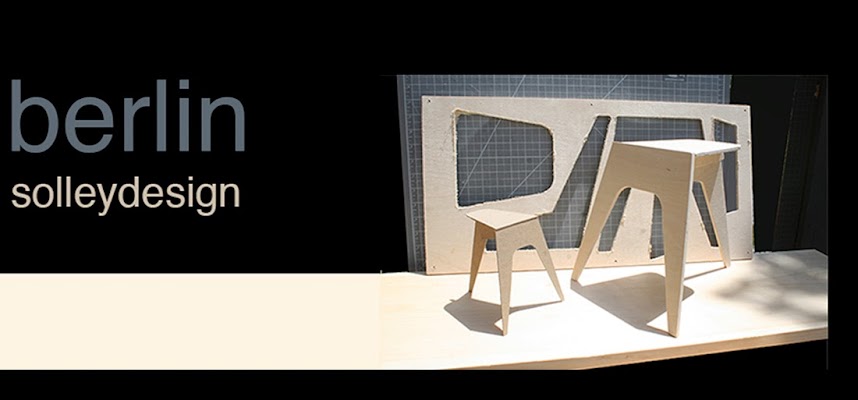Back in the USA, the STP stool will soon be manufactured locally. Fabrication begins in the first week of October 2015. For information on availability and costing, please visit our website.
Visit the STP homepage
The final TPC protoype
With only four fastenings around it's perimeter the seat yields elegantly to the weight of the occupant.
View the TPC homepage
View the TPC homepage
STP at the DMY
The little brother of the PCH chair also made it's debut in Berlin. The tension straps prove really successful in distributing load across the stool making in very robust, despite using no glue or mechanical fastenings.
View the STP homepage
View the STP homepage
PCH Final Design
The PCH chair made its debut at the DMY. The final design employs Linoleum on Multiplex plywood.You can learn more at our website.
View the PCH homepage
View the PCH homepage
DMY Weekend
The DMY show proved to be a great way to gauge feedback on the new Erfindsam products and we hope to participate again in the future.
PCH prototype
The base construction supports the seat and back units; these are plugged together and bend to support the unique posture of the occupant. You can try the final version at the the Berlin design show.
The DMY design show 2015
The DMY design show 2015
PCH joinery detail
The PCH chair employs the CNC router to create a series of interlocking parts. With no adhesive or mechanical fastenings the chair easy to pack up and take with you.
PCH chair connections
The PCH chair frame comprises of a kit of parts that can be connected with a series of flexible fastenings. The frame is held in tension allowing for an elegant sloping form.
CNC Undercarriage
The seat and back support assume their form by being held under tension. The fastenings to the chair base are created on the CNC router and connect at the flattest point.
Core Support
Two interlocking plywood profiles are held under tension. The forms yield to the weight of the occupant but spring back to their original form when unoccupied.
Full Scale Prototyping
Unlike conventionally upholstered furniture the exterior material requires minimal internal support to maintain it's appearance. However in order to support the weight of the occupant; a simple armature must be provided.
The TPC Concept
The TPC chair seeks to repurpose commercial carpeting. The design takes advantage of it's capacity to be folded into a load bearing form.
TPC Fastening
Laser cut corrugated cardboard proves to be an effective way to explore the flexible junctions to the design of more complex furniture forms.
Flexible Junctions
The simplification of assembly has taken us back to our flexible 'inner-tube' junctions. They provide a way to to build non-perpendicular shapes.
LED Lighting Unit
The STG lampe is illuminated by two banks of high powered LED's. These are mounted onto miniature circuit boards and connected to the Arduino microprocessor. The colors and intensities of each end of the lamp can be controlled independently
Friction Fastening
The STG
lamp employs 3D printed junctions. They use friction to secure each element and
maintain equal spacing between each dowel.
Strength through Compression
In order to simplify
the process of assembly we are trying to eliminate adhesive or mechanical fastenings.
These sketch models represent junctions that simply brace materials together.
Repurposing Home Electronics
This
hand held gaming controller is a product destined for obsolescence. Is there a
heaven for unused devices?
As part
of his course on Materiality in the Digital Realm, artist Wolfgang Spahn showed
me how to steer the laptop by altering the device. In this example the “numchuk”
is operating a small motor while data is simultaneously represented on the
computers screen. In other words the devices are communicating with each other.
Rotating Light
This
lighting unit is also a combination of optical illusion and physical computing.
The unit has been fabricated from surplus Plexiglas and laser cut to form a kit
of parts. A rotating wheel at the center forms one of three layers of
perforated material. The core is illuminated by LED strips, each programed
differently, to provide a variety of hues, intensities and unexpected
variations in the outward appearance.
Tactile Surfaces
This
video demonstrates the optical effects provided by the double skin of the tube
light. When the object is touched, the effect alters in relation to the movement
of the hand.
Licht Patrone
 The
strange optical effects created in the previous experiment, prompted me to
produce a second, larger, lighting unit.
This version comprises of two layers of perforated material. The unit is
hollow, allowing the light to be seen within and upon the surface
simultaneously. This results in an enhanced three-dimensional appearance.
The
strange optical effects created in the previous experiment, prompted me to
produce a second, larger, lighting unit.
This version comprises of two layers of perforated material. The unit is
hollow, allowing the light to be seen within and upon the surface
simultaneously. This results in an enhanced three-dimensional appearance. Red, Green and Blue
Returning to the Arduino, I explored how it can be used to control LED
lighting. Programming allows the RGB channels to be controlled separately
creating very subtle changes in the temperature of white. This means that the
LED can offer both warm and cool light and offer variations of intensity preferable to the end user.
Flexible Junctions
A
supply of cycle inner tubes enabled us to explore the many ways in which this flexible
material can be re-purposed. These fastenings are strong enough to hold rigid components
in place. They also enable the object to be deformed or assume a variety of
alternative shapes.
Ori-gummi
Examining one material in great detail prompted us to think about utility but we also became aware of the unique appearance of rubber. These free play exercises produced some very elegant artifacts.
Subscribe to:
Posts (Atom)






















